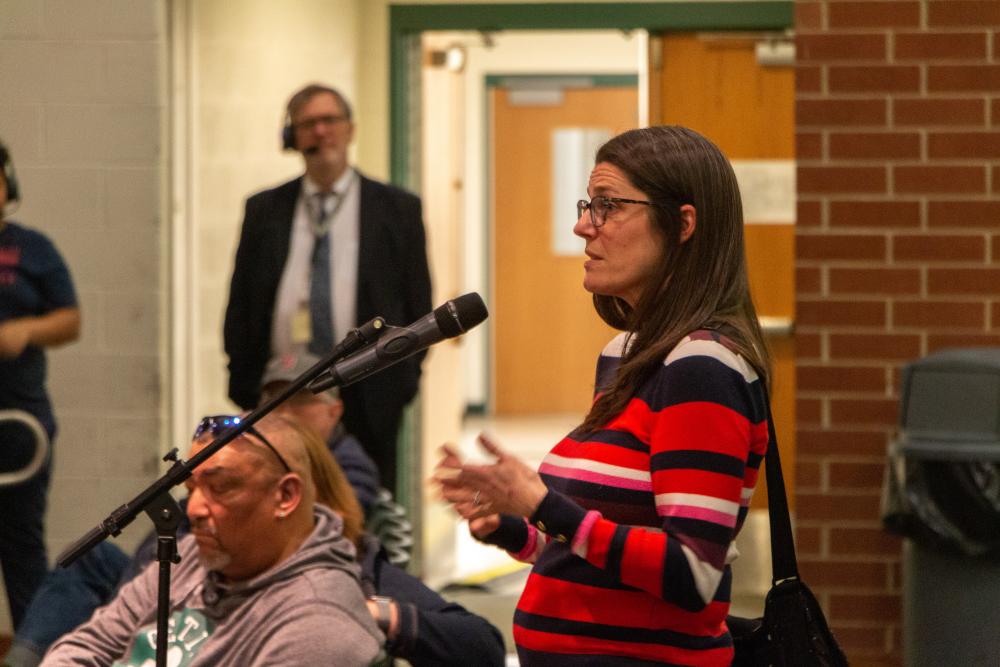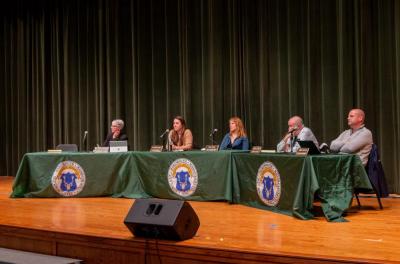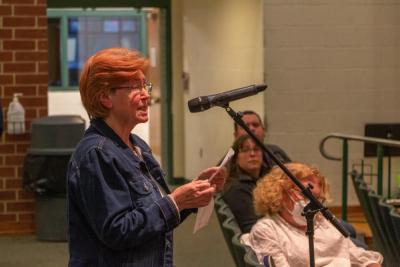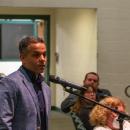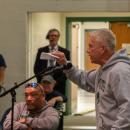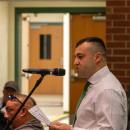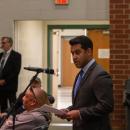Community speaks about Dartmouth Indian at public forum
Passions were high Tuesday night, as members of the public came out to the Dartmouth High auditorium to voice their opinions on whether the controversial Indian logo should stay or go at a public forum hosted by the School Committee.
Those in favor of keeping the Indian argued throughout the evening that the symbol was not offensive and is one of honor and respect, while those who want to see the name and symbol’s removal contend its continued use is outdated in 2022.
“To me, this issue is a simple one because it’s about how to treat people with respect,” said resident Doug Roscoe. “Something doesn’t need to offend all people to offend some.”
Though the discussion remained mostly civil throughout the evening, some speakers scolded School Committee members directly for addressing the logo issue at a time when other issues are pressing — several citing Covid-related mental health concerns specifically.
“All of you should be ashamed of yourselves,” Joann Avila said to the committee.
Another speaker, George Marcotte of the citizen’s group “Defend Dartmouth,” had to be reminded by committee Chair Dr. Shannon Jenkins to keep his remarks addressed to the committee after he strayed into a line of criticism directed at New Bedford NAACP President Dr. LaSella Hall.
After the forum concluded, School Committee member Mary Waite said she felt the speakers did a good job of capturing the complexities of the issue, but wished that the discussion could take place without personal attacks.
“We have people who are passionate, we just want to see them harness it a bit more productively,” she said. “We just need to get away from the name calling and tamp down on the rhetoric.”
Despite the occasional targeted remark, most speakers on both sides of the issue remained respectful to one another, with many attempting to find common ground or acknowledging that their counterparts were well-meaning.
“I think we all intended to wear the logo with pride and for the most part we did,” said Dartmouth resident Lee MacGregor, who added that she had always seen the Indian as a symbol of pride until going away to college and having some difficult conversations on the issue.
The discussion was introduced by opening speakers from both sides.
Representing those in favor of keeping the logo were Chris Pereira and two members of the Wampanoag tribe of Gay Head Aquinnah, Sean Carney and Jacob Ventura.
Those favoring its removal were led by Hall, former Diversity and Equality Subcommittee member Elizabeth Murphy, and Ann Fox.
Pro-logo speakers commonly cited school pride and unity as primary reasons to keep the logo. They also sought to counter claims that the symbol is offensive by pointing out that it was designed by Aquinnah Wampanoag tribal member Clyde Andrews, depicts a realistic eastern woodlands native, and uses the term “Indian” which is the federally recognized term for native peoples.
“[It’s] the universally accepted term of federally recognized tribes in their sovereign government-to-government relationship with the United States,” Ventura said. “Let us also resist the urge to let non-tribal people tell tribal people what is and isn’t offensive to us.”
Though some pushed back on the justification for the use of the term “Indian.”
“The NAACP is still called the NAACP but we don’t call black people colored people,” said Hanna Bordas, explaining that while the word ‘Indian’ is used in some official capacities such as in ‘the Bureau of Indian Affairs,’ it has largely been replaced by ‘Native American’ in common parlance.
Opponents of the logo largely framed the issue as a moral question and urged the committee to take a wider view of the Indian that encompasses the historical injustices native peoples have faced and how the logo is interpreted by those outside Dartmouth.
“The arc of history is long but it bends towards justice, my people would know,” Hall said. “We must continue with racial progress and oppose those that wish to stop it.”
Speakers opposing the logo also made clear that getting rid of the symbol would not mean erasing Native American culture or history.
“Colonial conquest, genocide, slavery, land theft, and the Indian schools were all used to erase indigenous people from this land,” he said. “But they are still here — like the Aquinnah who lived 10,000 years ago on the island of Noepe, or Martha’s Vineyard.”
“When the Indian replaced the harpoon as the school’s logo, did it erase the history of whaling?” asked Dartmouth resident David Ehrens, rhetorically.
Current students also weighed in on the debate, with differing viewpoints.
“All this fighting doesn’t help us,” said Dartmouth High freshman Natalie Murphy. “Let us wear uniforms that don’t make us worry about offending the people we’re playing against.”
Another student, though, said he felt immense pride when wearing the uniforms.
“When I put on that jersey, it brings me pride and strength,” said junior football player Jacob Lancaster. “There’s no greater pride than putting on that jersey.”
Though disagreements were fierce at times, there was a considerable amount of common ground between the two sides when it came to advancing educational programs about native peoples.
“Make some deliberate changes that will focus on indigenous people that were here prior to the rest of us,” Carney said.
Currently, indigenous history is taught primarily in the third grade.
Besides calls for increased cooperation with local tribes which were echoed widely, speakers individually made recommendations including: replacing Columbus Day with Indigenous People’s Day, specific guidelines for how the logo can be used, creating a display case honoring native history, building historical markers around town, and making tribal land statements before games.
After the forum, Superintendent of Schools Dr. Bonny Gifford said the administration would have a lot to think about regarding the educational elements of the discussion.
She did, however, express some frustration that many had blamed the schools entirely for what they saw as inadequate native education, calling it a “community issue.”
“People have to understand we have a Massachusetts curriculum we follow,” she said.
The debate over the name and logo will next head to a non-binding referendum on the April 5 town election ballot.
The choice to keep or remove the name and logo is ultimately up to the School Committee.



